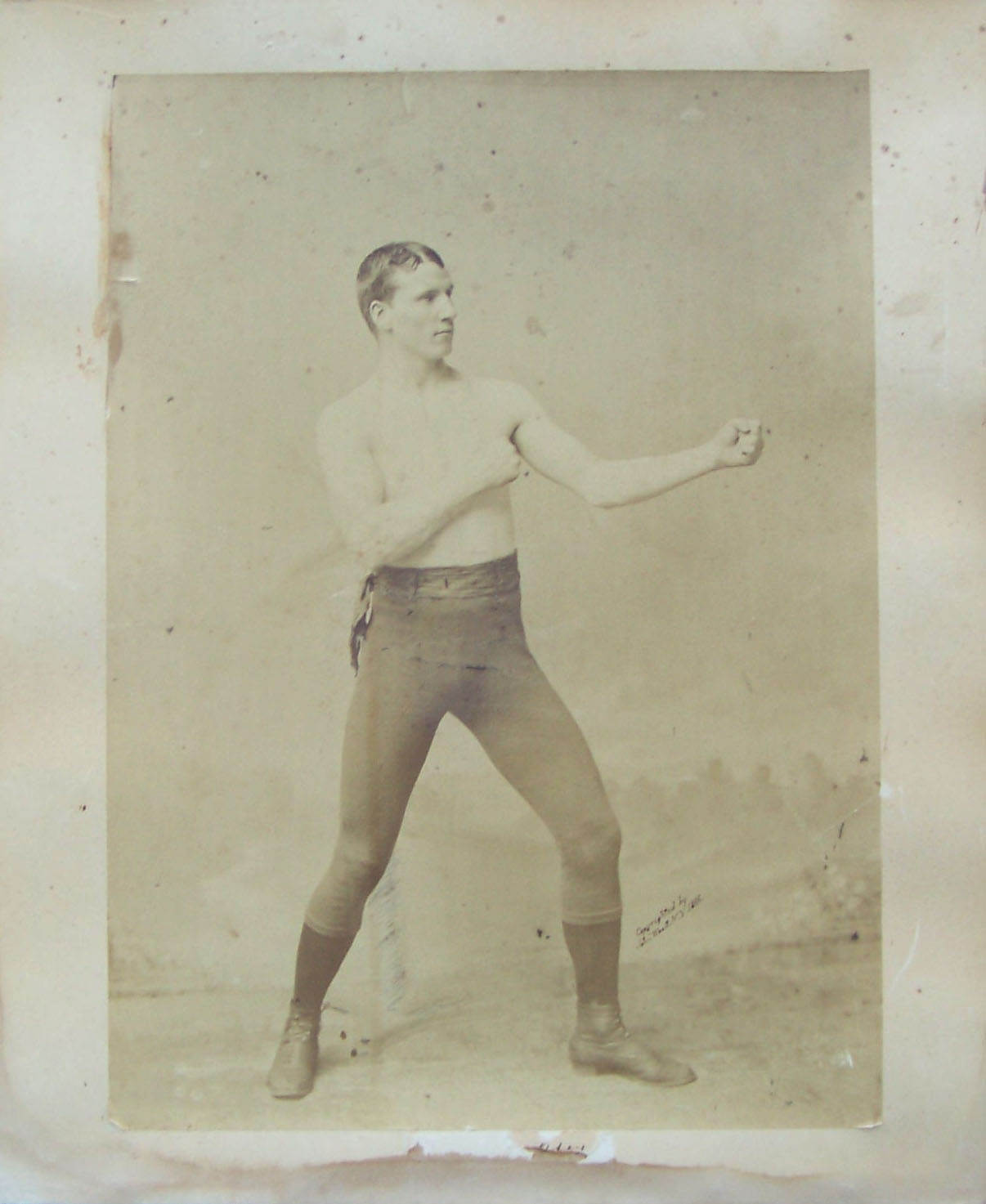
Nonpareil Jack Dempsey
World Middleweight Champion
1884 - 1891
 |
JOHN KELLY
b. December 15, 1862
d. November 2, 1895
|
A vintage-original large format photograph of middleweight champion Nonpareil Jack Dempsey... Photo is by John Wood ca. 1886 and is mounted... A very clear and detailed image of a 23-24 yr. old Dempsey in the prime of his career... Exceedingly rare in this size!!
JOHN WOOD PHOTOGRAPH
measures: 16 x 19.5" (mount), 12.25 x 17"
(photograph)
condition: some scattered foxing and staining as seen in scan, 1/4" closed tear
towards top left
$1,500
$30 insured shipping
This Jack Dempsey Was 'Nonpareil' : The 1880s Fighter Was World Middleweight Champion in John L. Sullivan's EraApril 23, 1992|EARL GUSTKEY | LA TIMES STAFF WRITER He looks at us through mists of time, from faded, crinkled 19th-Century photographs. It's the jaw that draws you to him. Massive, clean, squared off. The jaw shows that here, plainly, is a man from the warriorclass. And he was. He was Jack Dempsey, decades before anyone ever heard of that other Jack Dempsey, the 1920s heavyweight champion who took his name. The original Jack Dempsey was also known as "the Nonpareil," which means without equal. This, even though his career paralleled that of the famed 1880s heavyweight champion, John L. Sullivan. Dempsey was the world middleweight champion from 1884 to 1891. To a generation of American boxing followers, he was a fighter who first demonstrated that boxing can be performed as art, with style, grace and athleticism. Where Sullivan vanquished foes with brute strength, Dempsey was a craftsman who employed technique, strategy and guile. His life was short, but he touched nearly everyone who saw him fight. When he died in Portland, Ore., of tuberculosis, in 1895, he was only 32. Dempsey's great-great grandson is Scott Weber of Huntington Beach. Recently, Weber showed a visitor the boxer's gold-handled, ebony walking stick, given to him in Portland at a testimonial. Inscribed on the handle: "Presented to Jack Dempsey by a few of his Portland admirers. Sept. 91." Weber also has an ornate pewter inkwell set, with the fighter's name across the base in bold, raised letters: "JOHN E. DEMPSEY." "I never really knew much about him, but I'm still proud to be related to such a greatfighter," Weber, 48, said recently. "There are a lot of gaps in my knowledge of Dempsey, but among the things I do know is that he lived and died at 393 Grand Ave., Portland, the house he built when he was champion. It was torn down in the 1930s. "Also, I know that his real name was John Kelly. I'm not sure why he didn't use his real name, but it might have been because he didn't want his parents to know he was boxing. "My grandfather died in 1980 at 94, and he knew a lot about Jack Dempsey. I've always regretted not getting a lot of what he knew down on paper." Fate relegated Dempsey to second-billing in his era, beneath the heavyweight champion, Sullivan. The middleweight division was new (in Dempsey's time, the middleweight limit was 152 pounds instead of today's 160), and Dempsey is recognized today as the division's first true champion of the modern era. Apparently, he was deserving of his nickname. In his 1895 obituary in the Portland Oregonian, a writer penned: "Dempsey was cool under fire and never got rattled. . . . He changed his tactics in almost every battle, and his adversary never knew just how to size him up. "If a man made a rushing fight, Jack would give him a whirlwind scrap. If, on the other hand, his adversary made a defensive fight, Jack would take more time and whip him at leisure." Dempsey and Sullivan, in the 1880s, were America's first sports superstars, known coast tocoast. Born in Curran, County Kildare, Ireland, Dempsey grew up in Brooklyn. He was an apprentice cooper (a maker or repairer of barrels) when he began boxing, in 1883. He was unbeaten in 14 fights when he won the world middleweight title in 1884 by knocking out George Fuljames at Great Kill, N.Y. Dempsey's earnings seem puny by today's standards, but in the 1880s, few athletes made more. For his early major fights, his purses ranged from $500 to $3,500. When he was beaten by Bob Fitzsimmons in 1891, he earned his biggest purse, $12,000. It was a sum the New York Times reporter who covered the fight called "colossal." After his defeat by Fitzsimmons, Dempsey began showing symptoms of the tuberculosis that would kill him. Fitzsimmons went on to become heavyweight champion, knocking out Gentleman Jim Corbett three years later. The reason Dempsey changed his surname in his youth has been lost to history. Curiously, the 1920s heavyweight champion Jack Dempsey, whose given name was William Harrison Dempsey, was the fifth known boxer to have used the name Jack Dempsey. After the 1880s middleweight champion used it, heavyweight Jack Dempsey's three older brothers--Bernie, Johnnie and Harry--took the name. The youngest Dempsey then used it, after abandoning his Colorado mining camp fight name of "Kid Blackie." |
 |
 |